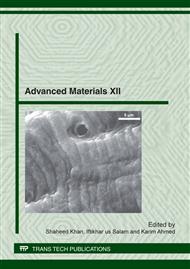p.307
p.315
p.321
p.330
p.335
p.343
p.348
p.356
p.364
Effect of Thermal Treatments on the Structural and Optical Properties of Thermally Deposited Polycrystalline Cu Thin Films
Abstract:
Copper thin films are potentially used in optical and laser applications due to their intrinsic reflective indexes in visible and infrared region of the spectrum. The reflective properties of the thin films are mainly driven by their thickness, structure, and residual strain induced during the processing stages. Copper thin films of various thicknesses were deposited on glass slides using a thermal evaporation unit. The deposited substrates were thermally treated, in inert environment for 30 minutes, for various temperatures. Further, the substrates were characterized using various techniques. Structural studies of the thin films were carried out using XRD on the as deposited and heat treated films to study the phases, the crystallographic preferred orientation, residual strain and crystallite size. The polycrystalline Cu phase was revealed and no oxide phases were identified. The films were preferentially oriented along (111). The crystallite size increases while the residual strain decreases as the film thickness increases. The crystallite sizes were very small as compared to the film thickness. The optical properties of these coatings were investigated by double beam spectrophotometer. It was found that reflectance of these coatings strongly depends upon the film thickness and post deposition heat treatment. The optimum deposition procedure was established to obtain the enhanced reflecting power.
Info:
Periodical:
Pages:
335-342
Citation:
Online since:
May 2012
Authors:
Keywords:
Price:
Сopyright:
© 2012 Trans Tech Publications Ltd. All Rights Reserved
Share:
Citation:


